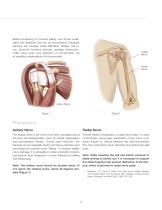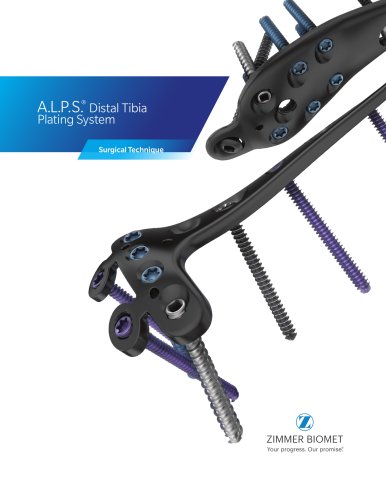 Website:
Zimmer Biomet
Website:
Zimmer Biomet
Group: Zimmer Biomet
Catalog excerpts

VersaNail ® Humeral Universal Nailing System Product Rationale & Surgical Technique
Open the catalog to page 1
Note: This brochure presents a surgical technique available for use with the Biomet, Inc., VersaNail® Platform instruments and implants. Surgeons may need to make modifications as appropriate in their own surgical technique with these devices depending on individual patient requirements. 1
Open the catalog to page 3
VersaNail ® Humeral Universal Nailing System One Implant Designed for the Efficient Treatment of a Range of Humeral Fractures • Anatomically designed for insertion in either the antegrade or retrograde approach The VersaNail® Humeral Universal Nail is part of a long bone nailing system that offers a complete portfolio of implants and instruments based on a single, standardized technology platform. The Humeral Universal Nail System from the VersaNail® Platform offers options to treat a range of humeral fractures using either the antegrade or retrograde approach with one implant. The...
Open the catalog to page 5
VersaNail ® Humeral Universal Nailing System The Humeral Universal Nail is designed to treat: • • • • Open and closed fracture patterns Humeral shaft fractures Fractures of the proximal and distal metaphysis Comminuted fractures of the humerus with small medullary canals • Fracture nonunions and malunions • Pathological fractures • Floating elbow 3.0 mm cannulation facilitates nail insertion over guide wire. Increased distal screw options: • • • • 3.5 mm for 7 and 8 mm nails 4.5 mm for 9 mm nail 2 transverse A-P screws 1 transverse L-M dynamization slot 4˚ Distal bend facilitates retrograde...
Open the catalog to page 6
End cap options to secure first proximal screw or second proximal screw (in oblique) and prevents bone in-growth. Versatile proximal screw options: • 4.5 mm and 4.8 mm for 7, 8, and 9 mm nails • 3 transverse screws • 1 oblique screw 2.5˚ Proximal bend ensures nail is located away from articular region when inserted in antegrade. Drive End Locking Options 60 mm
Open the catalog to page 7
Lateral-Medial (L-M) Locking Configurations Proximal holes: • 3 transverse holes • 1 oblique hole Distal holes: • 1 transverse slot Note: If using the oblique hole, do not use the first and second transverse hole. If utilizing the oblique hole and the most distal transverse hole, the screw tips may interfere with one another, depending on how far past the second cortex both screws are driven. Anterior-Posterior (A-P) Locking Configurations Distal holes: • 2 transverse holes
Open the catalog to page 8
Before embarking on humeral nailing, one should understand the obstacles that can be encountered. Adequate planning will minimize these difficulties. Rotator cuff injury, proximal humerus articular cartilage destruction, radial nerve injury and extension of comminution are all possible complications of this procedure. Axillary Nerve Radial Nerve Axillary Nerve Precautions Axillary Nerve Radial Nerve The axillary nerve is the nerve most often damaged during the injury and iatrogenically—even by closed manipulation and percutaneous fixation. During open reduction, the damage occurs especially...
Open the catalog to page 9
VersaNail ® Humeral Universal Nailing System Antegrade Entry and Canal Prep Patient Positioning A bolster can be utilized to elevate the shoulder from the table and to allow shoulder extension (Figure 4). Position the patient supine in the beach chair position on a radiolucent table (Figure 3). To allow easy access to the proximal humerus, it is helpful and recommended to place the C-arm on the opposite side of the table of the injured limb. The C-arm should also be positioned so it is parallel with the head of the patient to allow an axial view of the humeral head. Note: It is not possible...
Open the catalog to page 10
Humeral Head Reduction Fracture reduction is accomplished by adducting and extending the proximal fragment with the aid of the joystick while an assistant simultaneously maintains longitudinal traction on the distal arm (Figure 8, right). The humeral head is typically in a varus or valgus position due to contraction of the rotator cuff muscles and the force of impaction during injury (Figure 7, top). Manipulation of the humeral head is accomplished by drilling one or two K-wires lateral to medial in the anterior and posterior portions of the humeral head (Figure 7, bottom). Using the...
Open the catalog to page 11
VersaNail ® Humeral Universal Nailing System Nail Image intensification can be used to place a K-wire through the humeral head in line with the intra-medullary axis of the humerus (Figure 9). manually to obtain two orthogonal views of the head in reference to the shaft. Finally, a guide pin centered axially and laterally through the frontal plane between the two K-wires will offer ideal nail entry site identification. The jig arm should go between both K-wires (Figure 10). There are some key considerations to this approach. The first is to use the joysticks to extend and adduct the humeral...
Open the catalog to page 12
Entry Site and Incision Placement Soft Tissue Protection Make an incision just anterior to the anterior edge of the acromion. The anterior edge may be difficult to palpate and differentiate from the humeral head due to edema and hematoma from the fracture. Therefore, it is helpful to use a K-wire under image intensification to locate the anterior edge of the acromion angle where it intersects the longitudinal axis of the humerus (Figure 11). In cases where the greater tuberosity is intact or nondisplaced, a 1 to 1.5 cm incision can be made in the supraspinatus tendon in line with its...
Open the catalog to page 13
VersaNail ® Humeral Universal Nailing System A starting point is made with a threaded 3.2 mm x 14 Inch Guide Pin (Cat. No. 14012–14) and a Curved Cannulated awl (Cat. No. 2810-01-005). Use A-P and lateral fluoroscope views to confirm accurate placement. The entry site in the humeral head is made with the Cannulated Proximal Nail Entry Reamer (Cat. No. 2810-18-002) over the 3.2 mm x 14 inch guide pin about 1 to 1.5 mm above the bicipital groove, which is aligned with the intramedullary canal (Figure 14). After the head has been reamed to the desired size, fluoroscopically verify the entry...
Open the catalog to page 14All Zimmer Biomet catalogs and technical brochures
-
MODULAR FEMORAL Revision System
14 Pages
-
A.L.P.S.®
44 Pages
-
Constrained Posterior Stabilized
12 Pages
-
Persona PERSONALIZED KNEE
7 Pages
-
Avenir® Femoral Hip System
12 Pages
-
The CLS® Spotorno® Stem
16 Pages
-
Alloclassic®Zweymüller®Stem
12 Pages
-
®Zimmer® Segmental System
6 Pages
-
NexGen® RH Knee
8 Pages
-
Persona-Partial
12 Pages
-
Zimmer Natural Nail System
8 Pages
-
tourniquet-systems-brochure
8 Pages
-
modern-cementing-technique
16 Pages
-
CoAxial Spray Kit
8 Pages
-
Biologics
24 Pages
-
PowerPump DP System
2 Pages
-
Sidus
40 Pages
-
Ankle Fix System 4.0
8 Pages
-
Anatomical Shoulder System
6 Pages
-
Fitmore Hip Stems
6 Pages
-
NexGen High-Flex Implant
8 Pages
-
Trabecular Metal ™Glenoid
4 Pages
-
Anatomical Shoulder ™ System
6 Pages
-
Zimmer ® PSI Shoulder
6 Pages
-
Zimmer personna
12 Pages
-
ZImmer iASSIST
44 Pages
-
Fitmore ® Hip Stem
24 Pages
-
Persona Knee
6 Pages
-
Trauma Solutions
10 Pages
-
Colagen Repair Patch
2 Pages
Archived catalogs
-
Fitmore® Hip Stem
6 Pages
-
Zimmer® Segmental System
6 Pages
























































































